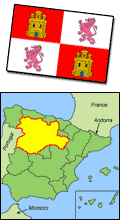 |
 Castile
and Leon Castile
and Leon
The nine provinces of Castile and Leon are:
- Segovia
- Avila
- Soria
- Burgos
- Palencia
- Valladolid
- Leon
- Zamora
- Salamanca
This large region, set on an enormous, peculiar platform
known as the meseta, has exceptional characteristics and geomorphology
and includes the territory of the ancient kingdom of Leon and
northern half of old kingdom of Castille. It has a grandiose
infinitely flat countryside and truly splendorous historical
and architectural heritage.
 Segovia has a magnificent Roman aqueduct, the finest example
of its epoch and style of all those still in existence. It
also has other important treasures from different ages, such
as several precious Romanesque churches, a large Gothic cathedral
and the splendid Alcazar, a Moorish fortress that has incorporated
elements from diverse epochs.
Segovia has a magnificent Roman aqueduct, the finest example
of its epoch and style of all those still in existence. It
also has other important treasures from different ages, such
as several precious Romanesque churches, a large Gothic cathedral
and the splendid Alcazar, a Moorish fortress that has incorporated
elements from diverse epochs.
Avila, the birthplace of St. Theresa of Jesus, has preserved
in an exceptional fashion its old medieval walls, an impressive
fortification built in Romanesque times. It also has other
magnificent treasure, such as the Basilica of Saint Vincent.
Its cathedral, of the Cistercian Order, is set into the ancient
walls.
Soria, of Celt Iberian origin is bathed by the Duero River.
Among its many civil and religious buildings are many Romanesque
structures, such as the Church of Santo Domingo and Cloister
of San Juan de Duero, from the 12-13th Centuries.
Burgos not only enjoys the honour of being the birthplace
of El Cid but has a Gothic cathedral of exceptional quality
and beauty that is one of the finest in Spain. Its Old Quarter
also preserves beautiful medieval and Renaissance churches
and palaces.
Palencia, maintains a marked medieval flavour. Presided over
by a marvellous Late Gothic cathedral, this little known city
has many architectural treasures of interest and a magnificent
archaeology museum.
Valladolid, the current capital of Castilla-Leon, is the largest
city in the region. Famous for its beautiful gardens and the
solemnity and grace of its Holy Week celebrations, it also
has a cathedral and two magnificent Plateresque buildings -
the Santa Cruz College and San Gregorio´s. Its Sculpture
Museum, with an incomparable collection of the works of the
greatest Spanish artists from the 16th and 17th centuries,
including Berruguete, is one the most important in the country.
Leon, former capital of the region of the same name, essentially
has three architectural treasures of the highest merit: The
12th century Royal Basilica of San Isidoro, with a crypt decorated
with Romanesque frescoes of exceptional quality; the Gothic
Cathedral, of singular beauty and purity, whose innumerable
stained-glass windows can only be compared to those of Chartres;
and the ancient San Marcos Convent, a splendid Renaissance
building that is currently a luxurious Parador or tourist hotel.
Zamora, south of Leon, is a city with a medieval flavour,
artistically marked by the Romanesque Style, of which it has
preserved nearly a dozen churches and a magnificent cathedral,
topped by a strange Byzantine dome. A few kilometres from the
city is the rare and valuable Visigothic church of San Pedro
de la Nave, from the 8th century.
Salamanca was famous during the Renaissance due to its important
university, one of the first in Europe. The city has exceptionally
beautiful and has many architectural treasures, such as its
two cathedrals (the old Cathedral, in Romanesque style and
the New Cathedral, Gothic in style with Plateresque elements),
the arcaded Plaza Mayor, or main square, and the Renaissance
University building, with a splendid façade, among others.
 |

See
what tours we have available here! |
Book Organized Tours of Spain
Popular tours sell out well in advance! Don't be
disappointed!
Reduce stress! Don't waste time haggling with the hotel concierge.
Lock in your price! Currency dips & price hikes won't effect you.
Save vacation time! Plan & book now, not when you're there.
Balance your vacation budget! Charge tours on this month's credit card bill. |
|

See
what tours we have available here! |
 |
|
 |




